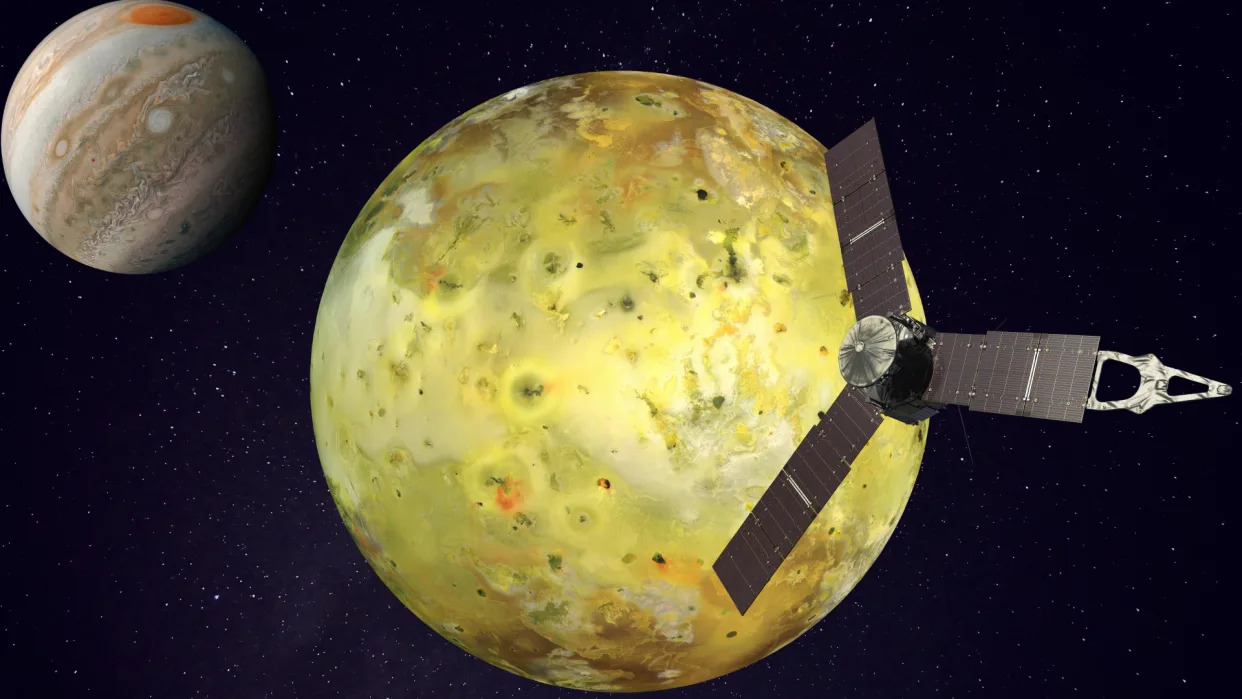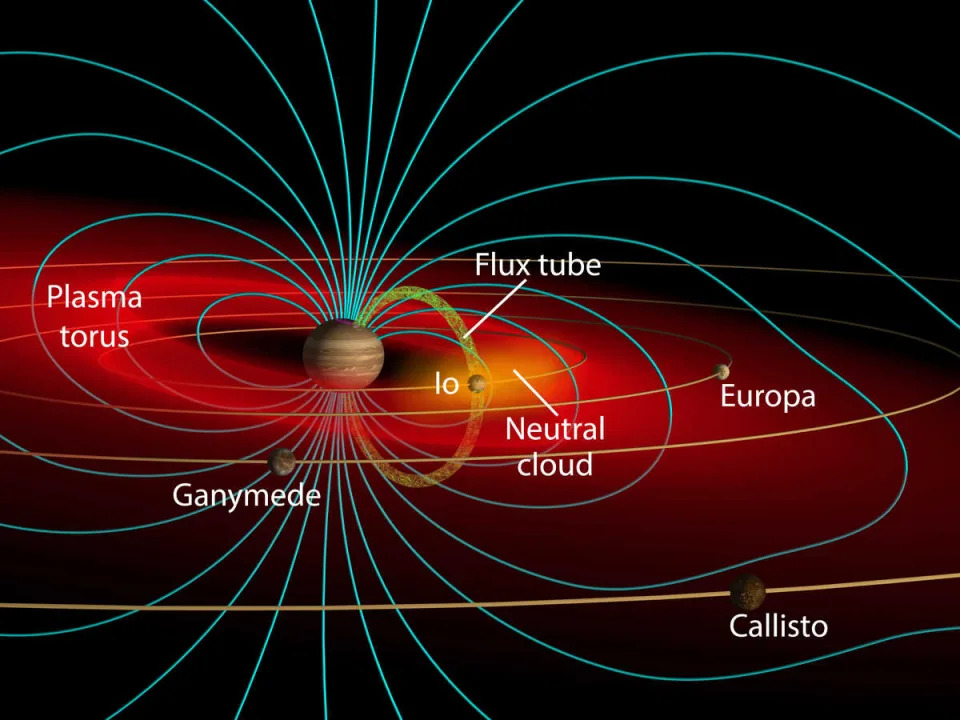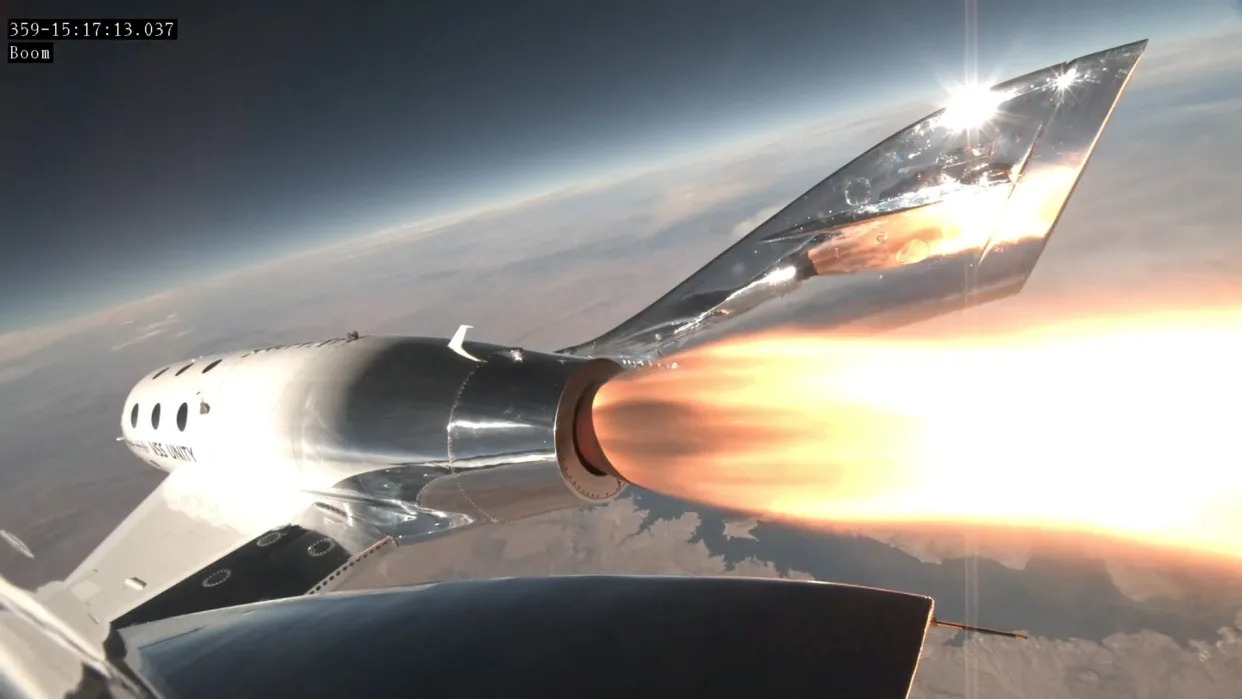Robert Lea
Mon, August 28, 2023

An illustration shows the Juno spacecraft flying past Io as Jupiter lurks in the background.
The James Webb Space Telescope (JWST) and the Hubble Space Telescope are set to team up and observe the solar system's most volcanic body: A moon of Jupiter named Io.
The two space telescopes will remotely collect data about the intriguing world, then that information will be put to use by NASA's Juno spacecraft. More specifically, the data will help guide Juno during future flybys of Io, as the probe investigates how the highly volcanic moon may contribute to plasma present in the environment around Jupiter.
The investigation will conducted by the Southwest Research Institute (SwRI), an organization that has been granted JWST and Hubble observing time by the Space Telescope Science Institute. The SwRI team will collect Io data with Hubble during 122 of the telescope's orbits around Earth, as well as supplement those findings with almost five hours of JWST observing time.
"The timing of this project is critical," Kurt Retherford, principal investigator of the campaign and SwRI researcher, said in a statement. "Over the next year, Juno will buzz past Io several times, offering rare opportunities to combine in-situ and remote observations of this complex system."
Related: Massive, months-long volcanic eruption roils Jupiter's moon Io
"We hope to gain new insights into Io’s dramatic volcanism, plasma-moon interactions and the neutral gas and plasma populations that propagate through Jupiter's vast magnetosphere and trigger intense Jovian auroral emissions," Retherford added.
NASA estimates that Io's surface is punctuated by hundreds of actively erupting volcanoes that can blast lava dozens of miles into the Jovian moon's thin, waterless atmosphere.
Io, which is around the size of Earth's moon and the innermost Galilean satellite of Jupiter, is believed to be so extremely volcanic because the gravitational influences of its host planet generate tidal forces that squash and squeeze this moon. Other Jovian moons, including the rest of the Galilean satellites, have a similar effect on Io too, further exacerbating this gravitational storm.
These forces are so powerful, in fact, that they can provoke the surface of Io to rise and fall by as much as 330 feet (100 meters). And as you might expect, such extreme volcanism affects the entire Jovian system.
Io's extreme volcanism drives donut cloud around Jupiter

A diagram of the Jovian system and a plasma torus that traps charged particles escaping the atmosphere of Io.
(Image credit: Courtesy of SwRI/John Spencer )
Particles escaping from Io's atmosphere, for instance, are believed to be a major source of material trapped in Jupiter's magnetic field. These escaping atmospheric gases are ionized, meaning they undergo a process in which extreme heat rips electrons from atoms to create a dynamic sea of charged particles.
"Most of these materials don’t actually escape straight out of the volcanoes but rather are associated with the sublimation of sulfur dioxide frost from Io's dayside surface," Katherine de Kleer, project co-investigator and scientist at Caltech, said in the statement. "The interaction between Io’s atmosphere and the surrounding plasma provides the escape mechanism for gases released from the moon's frozen surface."
This forms a doughnut-shaped cloud of charged particles, called the Io Plasma Torus (IPT), surrounding Jupiter. When electrons collide with ions in the IPT, they create ultraviolet radiation that can be detected by telescopes here on Earth and in space.
Continued investigation is needed to fully understand the IPT, however, because it is difficult to assess how strong its connection to Io's volcanism actually is. It's also an open question as to what effects Io has on other bodies in the Jovian system, such as those other large Galilean moons.
"For example, how much sulfur is transported from Io to Europa's surface? How do auroral features on Io compare with aurora on Earth — the northern lights — and Jupiter?" Fran Bagenal, project co-principal investigator and researcher at the University of Colorado at Boulder, said in the statement.
The team believes the key to better understanding these connections is by investigating the Jovian system as a whole rather than in pieces. And that requires more data than even Juno, as impressive as it is, can provide.
Particles escaping from Io's atmosphere, for instance, are believed to be a major source of material trapped in Jupiter's magnetic field. These escaping atmospheric gases are ionized, meaning they undergo a process in which extreme heat rips electrons from atoms to create a dynamic sea of charged particles.
"Most of these materials don’t actually escape straight out of the volcanoes but rather are associated with the sublimation of sulfur dioxide frost from Io's dayside surface," Katherine de Kleer, project co-investigator and scientist at Caltech, said in the statement. "The interaction between Io’s atmosphere and the surrounding plasma provides the escape mechanism for gases released from the moon's frozen surface."
This forms a doughnut-shaped cloud of charged particles, called the Io Plasma Torus (IPT), surrounding Jupiter. When electrons collide with ions in the IPT, they create ultraviolet radiation that can be detected by telescopes here on Earth and in space.
Continued investigation is needed to fully understand the IPT, however, because it is difficult to assess how strong its connection to Io's volcanism actually is. It's also an open question as to what effects Io has on other bodies in the Jovian system, such as those other large Galilean moons.
"For example, how much sulfur is transported from Io to Europa's surface? How do auroral features on Io compare with aurora on Earth — the northern lights — and Jupiter?" Fran Bagenal, project co-principal investigator and researcher at the University of Colorado at Boulder, said in the statement.
The team believes the key to better understanding these connections is by investigating the Jovian system as a whole rather than in pieces. And that requires more data than even Juno, as impressive as it is, can provide.
"Hey Hubble ... watch this!"

Io as seen by Juno's JIRAM instruments shows volcanic hotspots across the fiery moon. (Image credit: NASA/JPL-Caltech/SwRI/ASI/INAF/JIRAM )
Related Stories:
— NASA's Juno probe finds giant swirling waves in Jupiter's magnetosphere
— Jupiter's volcanic moon Io glows red in incredible images from NASA's Juno
— Jupiter's lightning is strikingly similar to Earth's
Juno has been investigating the Jovian system and its environment since July 4, 2016, when it arrived in the vicinity of the gas giant and its moons after a 1.7 billion-mile journey from Earth. This was a journey that took five years to complete.
Since then, the spacecraft has completed several flybys of both Jupiter and its large moons, notably Europa. It last flew past Io on July 30, coming within around 13,700 miles (22,000 kilometers) of the fiery moon while collecting data about its atmosphere and magnetic field. Juno will get particularly close to Io again on Dec. 30 of this year then again on Feb. 1, 2024.
On Sept. 20, however, Juno will make a more distant pass of Io that will be of particular interest to the SwRI team. This flyby of Io will be timed such that it can be observed by Hubble and the JWST simultaneously.
That means the two telescopes will get the chance to team up and observe what Juno sees, but at a distance, giving scientists the holistic view of the Jovian system they're after.
"The chance for a holistic approach to Io investigations has not been available since a series of Galileo spacecraft flybys in 1999 to 2000 were supported by Hubble with a prolific 30-orbit campaign," Retherford concluded. "The combination of Juno’s intensive in-situ measurements with our remote-sensing observations will undoubtedly advance our understanding of Io's role in driving coupled phenomena in the Jupiter system."
Even though future missions to Jupiter and its moons are in the cards, with the Europa Clipper and Jupiter Icy Moons Explorer (JUICE) set to arrive at the Jovian system between 2029 and 2031, neither will fly by Io.
That means, according to the SwRI, another chance to make these kinds of observations won't arise until at least the 2030s.
Virgin Galactic to launch next space tourist flight on Sept. 8
Mike Wall
Mon, August 28, 2023

a silver-white space plane fires its rocket motor with the curve of Earth and the blackness of space in the background
Virgin Galactic's next spaceflight is less then two weeks away.
The company announced today (Aug. 28) that it's targeting Sept. 8 for the launch of Galactic 03, its third commercial spaceflight and eighth space mission overall.
Galactic 03 will take three paying customers to and from suborbital space from Spaceport America in New Mexico. Virgin Galactic hasn't identified those passengers yet, but we know they've been ticket-holders for a long time.
Related: Virgin Galactic launches 1st mother-daughter team and 1st Olympian to space on 2nd commercial flight (video)
"The three Galactic 03 crewmembers are the first of Virgin Galactic's group of 'Founder' astronauts — the first customers whose forward-thinking vision and early ticket purchases helped make the dream of regular commercial spaceflights a reality," Virgin Galactic wrote in a statement today.
"The Galactic 03 crew bought their tickets as early as 2005 and, since then, have been an active part of the company's vibrant Future Astronaut community," they added.
The trio will become Virgin Galactic's 14th, 15th and 16th astronauts, according to the company. They'll fly with Colin Bennett, one of Virgin Galactic's astronaut instructors.
RELATED STORIES:
— Meet the crew of Virgin Galactic's 1st commercial spaceflight
— Meet the crew of Virgin Galactic's 2nd commercial spaceflight
— Space tourism companies might learn a lesson from the Titan sub disaster. But are they ready to listen?
Galactic 03's passengers will ride in VSS Unity, Virgin Galactic's space place, which will be piloted by Nicola Pecile and Michael Masucci. The vehicle will lift off beneath the wings of the company's carrier aircraft, VMS Eve, which will drop it at an altitude of about 50,000 feet (15,000 meters).
Unity will then fire up its onboard rocket motor, making its own way to suborbital space. The passengers will get to experience a few minutes of weightlessness and see Earth against the blackness of space before coming back down for a runway landing at Spaceport America.
The most recent such flight, Galactic 02, lifted off on Aug. 10, carrying a former Olympian and a mother-daughter duo to the final frontier for the first time. The daughter in that duo, an 18-year-old college student, also became the youngest person ever to reach space, according to Virgin Galactic.
Virgin Galactic is currently selling tickets for $450,000, but, given that the three customers on Galactic 03 are "founding astronauts," they likely didn't pay that much; the seat price has gone up a few times over the years.
No comments:
Post a Comment